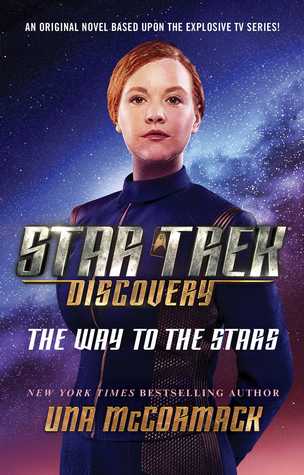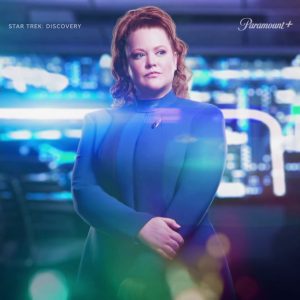Hopefully, without sounding as though I’m disparaging Extended Universe or media tie-in novels, The Way to the Stars by Una McCormack is, technically, a Star Trek novel. However, you can ignore that entirely for the purposes of this book and this review, trust me. Pretend as though you didn’t realize there is a connection until we get to the end.

BOOK INFORMATION
Genres: Science Fiction, Coming-of-Age
First Released: 2019
Part of a Series: Technically, yes, but the novel itself stands alone in terms of plot/readability/etc.
Call Number: SCI FI MCCORMACK
Eyan’s Rating: 4.5/5
Find it: Physical copy on the 3rd floor
SUMMARY
It’s not easy being sixteen, especially when everyone expects great things from Tilly. It’s even harder when her mother and father are Federation luminaries, not to mention pressing her to attend one of the best schools that the Federation has to offer. Tilly wants to achieve great things—even though she hasn’t quite worked out how to do that or what it is she wants to do. But this year, everything will change for Tilly, as she is about to embark upon the adventure of a lifetime—an adventure that will take her ever closer to the stars.
EYAN’S REVIEW
Sylvia Tilly is, perhaps, the Star Trek character I currently relate the most to. When I decided to pick up Trek tie-in novels for the first time, starting with a character I loved on-screen seemed the way to go. But, I said we’d leave that bit for the end, didn’t I?
The novel opens with a framing narrative. Basically, a way to situate what is going to happen inside the mythos of Trek. If you want, you can skip that opening chapter. Tilly is explaining to her friend Michael how she ended up at Starfleet, taking us back to the year she was 16.
16-year-old Tilly is, maybe, every bit as dramatic as I was at 16. I loved her for the realistic and relatable depiction of the teenage experience on the page, without it feeling like the author was making teenagers more childish than they really are—a common flaw I find in most “adult” fiction with teen or child characters. This book is not marketed as YA, despite the age of Tilly throughout, but it could be a YA novel. It’s a traditional bildungsroman—the literary term for “coming-of-age stories,” which find their home most often in an audience of peers. As an adult, though, what makes Tilly’s struggle so profound is her relationship with her mother.
At the start of the novel, we learn of the extraordinary pressure Tilly’s mom has always placed on her to be the absolute best, to follow in her footsteps and to one day join the diplomatic core of the Federation. Tilly’s father, divorced from her mother though amicable, serves long stretches of time on a Federation science vessel, out of real-time conversational range with his daughter. Tilly has been, for the past few months, living with her maternal grandmother and step-grandfather in Paris. Her mother decides to send her away to an exclusive boarding school designed for children of diplomats.
When Tilly arrives at her new school, she knows it’s time to stand up for herself, but she can never quite seem to do so. Between the pressure from her mother, living with a roommate for the first time, balancing an incredible workload and trying to find time to squeeze in engineering projects, Tilly only manages to stand firm on her new name, switching from her first name Sylvia to her last name, Tilly.
 Tilly’s passions and her strengths lie in engineering. She has a natural mind for curiosity and discovery and manages to fix nearly any electronic device she comes in contact with. She is also a brilliant student in the emerging field of astromycology (the study of alien fungi). Her mother and her classmates always disparage this interest in “mushrooms,” but it is her father that reframes the struggle for her. He tells her that he used to disparage himself and his field, too, referring to his work as “relics” or “digging in the dirt” instead of with the proper names associated with his type of archaeology. He said once he switched to the proper term, he took himself more seriously, and that made everyone else do so, too. For Tilly, she isn’t interested in “mushrooms” or “fungus,” but in astromycology; the words give the field authority and respect—this is a constant struggle in today’s society, too. Language is the tool of authority. By internalizing those standards, are we harming our own loves and passions subconsciously? McCormack certainly thinks so, as Tilly’s struggle is not one of ability but one of comparison.
Tilly’s passions and her strengths lie in engineering. She has a natural mind for curiosity and discovery and manages to fix nearly any electronic device she comes in contact with. She is also a brilliant student in the emerging field of astromycology (the study of alien fungi). Her mother and her classmates always disparage this interest in “mushrooms,” but it is her father that reframes the struggle for her. He tells her that he used to disparage himself and his field, too, referring to his work as “relics” or “digging in the dirt” instead of with the proper names associated with his type of archaeology. He said once he switched to the proper term, he took himself more seriously, and that made everyone else do so, too. For Tilly, she isn’t interested in “mushrooms” or “fungus,” but in astromycology; the words give the field authority and respect—this is a constant struggle in today’s society, too. Language is the tool of authority. By internalizing those standards, are we harming our own loves and passions subconsciously? McCormack certainly thinks so, as Tilly’s struggle is not one of ability but one of comparison.
Ultimately, Tilly finds her place in the world, as we see her on Star Trek: Discovery as played by the incredible Mary Wiseman. The Way to the Stars is not about the whole journey, though, just about the start. It’s about finding yourself in a world where you can do anything. About the pressures of love and family against the backdrop of personhood and growing up.
So, how much does it matter that Tilly is a Star Trek character? Well, knowing what I know about her run on the 4 seasons of Discovery to date helped with some context. But, you could read this without knowing a single thing related to Trek and be just fine. The science-fiction that seeps into the story involves location, like when Tilly gets sent off-world to boarding school. The astromycology in-world doesn’t exist exactly in our own, but it’s not like we delve into the science of it in the novel. We just hear about it in the same broad way we’d hear about something like astrophysics today. The book functions as a stand-alone for this reason. We’re learning about one year in Tilly’s life, not her entire journey to date.
I very much enjoyed the book, and it’s making me search out more Trek novels by McCormack. We’re also waiting for Season 5 of Discovery to air and Season 4 to release on DVD, but the library has the first 3 seasons. It’s a great entryway into Trek for new viewers, as well. You don’t need to have any background information to follow what’s going on. The show has a new ship and mostly new characters to follow. While the main protagonist, Michael Burnham, is the human adopted sibling of Spock, the timeline for the show’s opening season is about a decade before the start of The Original Series. Everything that happens, therefore, is new to viewers. It’s a bit darker than the average Trek series, with a focus on found family, finding your way and finding yourself. I love it.
